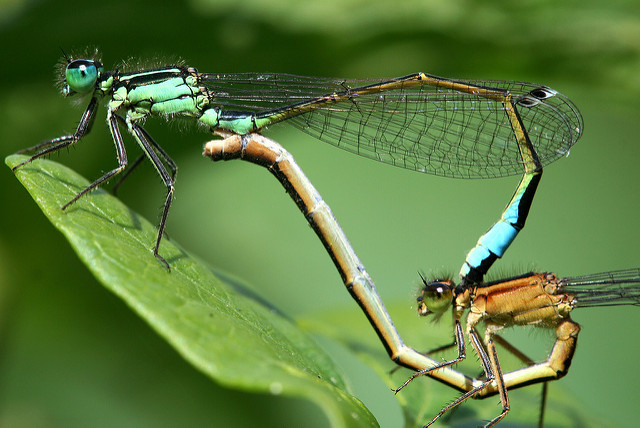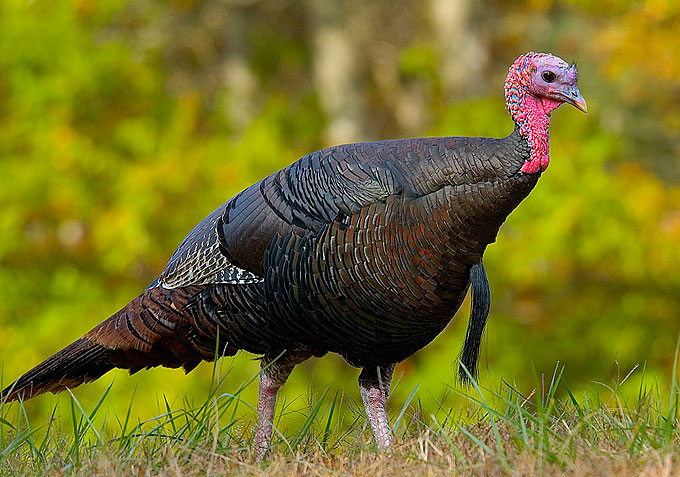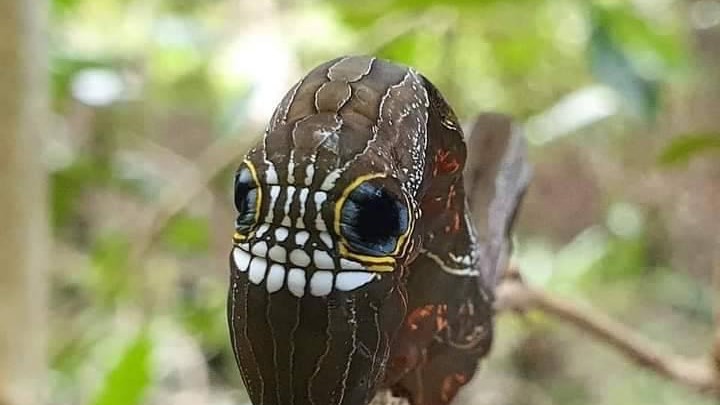As the days grow longer and the temperature rises, the first vestiges of animal and plant life have begun to shake off the trappings of winter. Tender buds break open to reveal tightly packed profusions of floral color. Bird song greets the early morning sun and small animals stir from their dens. Insects begin to hatch from overwintered eggs or stretch their legs/wings after a long diapause. As the natural world awakens from winter quiescence, much of this activity takes the form of ensuring the continuation of the next generation.
In that spirit, let’s examine some surprising recent findings on the mating system of a damselfly, known as Ischnura ramburii, or Rambur’s forktail.
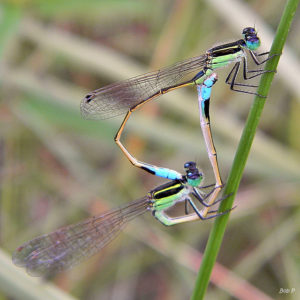
While much emphasis is placed on biodiversity in the sense of density of species on the planet, there is often just as much diversity exhibited in the way species approach the ubiquitous problems of life, such as resource acquisition and reproduction. Particularly, conflict between the sexes of a species can influence mating systems, speciation and population dynamics. A mating system is the collection of behaviors individuals in a species use during reproduction. A recent study, conducted by Dr. Eben Gering, looked into how a specific trait, male mimicry in females, evolved due to the unique pressures experienced by Rambur’s forktail damselfly.
Conflicts between males and females often abound in nature. Eggs are heavy and take a lot of energy to produce, while sperm are light and easily made. Conflicts arise because mating almost always benefits males, who can pass their genetic material to the next generation with light investment. In contrast, additional mating can have an adverse effect on females who often have more invested in reproduction, simply due to the greater difficulty in producing eggs. This imbalance sometimes places selection on populations to evolve sex-specific traits. These effects include male phenotypes that evolve to facilitate more reproduction with females, as well as female traits to combat male manipulation. For insects that don’t engage in a lot of physical contact with members of their own species, just the act of mating can be physically dangerous, risking injury just by association. Mating systems often evolve as a form of conflict resolution between the sexes, balancing each side’s benefit from passing on genes, while minimizing unnecessary expenditures of energy or the risk of physical damage.
Some mating systems can seem strange if they were imagined in the context of humans. For the study of biology, we must learn to observe these conflicts not on the basis of human notions of equality or morality, but rather as a fascinating illustration of how evolution can lead to unique and surprising outcomes to problems that most species encounter.
The interplay of mating rates between individuals can scale up to effect larger processes within populations, such as population growth rates, which will determine whether the group remains viable over time. Some recent studies have examined these connections between conflict and demography (population studies), but Gering’s study deals with a subtler dimension to how the effects of conflict play out among animals. In damselflies, males often harass females in search of an opportunity to mate. Suppose that an encounter with a potential mate were to produce a lingering effect on an individual’s behavior for some reason. This change would influence any other mates encountered in the future. If these indirect effects were to alter rates of male harassment on females, the subsequent reproductive output would be adversely effected and potentially lead to limits on population growth.
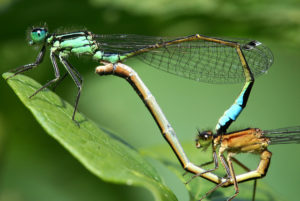
This particular study deals with the indirect effects of a conflict-related trait seen in a damselfly from the family Coenagrionidae. As mentioned before, male damselflies will harass females and this behavior can lead to a reduced fitness for those females. However, an amazing adaptation has evolved that allows the females to counter this effect. Within more than 100 species of Coenagrionidae, brightly colored “andromorph” females, which resemble male damselflies, co-occur with more drab “gynomorph” females. This difference in appearance is determined by a gene variant (an allele) in these individuals. The “andromorph” resemblance to male damselflies is understood to help females avoid male detection and harassment. In response to a successful mating, males learn to focus their search for future mates based on a resemblance to their previously encountered females. Refining their search in this way can result in negative frequency dependent harassment of the different female morphs, meaning that the fitness of given morphs becomes less as the morph becomes more common in a given area. To put another way, the female posing as a male to avoid harassment, once encountered by a male damselfly, increases the likelihood that other andromorphs as well as males will subsequently be harassed. The overall effect is to reduce harassment on females of both morphs. Each attempted mating results in a cost to each participant, but doubly so if both participants are male and have no access to the benefits of reproduction. Therefore, the ability of males to hone their search criteria after each encounter may help explain the evolution of different types of female morphs. This mating system has arisen as a result of the conflict between the sexes, and it persists because it allow the costs and benefits of mating behaviors in both sexes to be balanced out.
By placing groups of damselflies within outdoor enclosures while varying each group’s density, Gering was able to observe how the presence of andromorphs altered male behavior and fitness (measured by mortality and body mass). These observations yielded several insights into how population density and morph frequency affect populations. First, high mortality rates in both the densest groupings and ones with higher andromorph frequency support the idea that costly male-male interactions increased as the presence of male-mimicking females increased. Similarly, body mass for males was found to be lower in enclosures with high population density as well as those with high andromorph frequency. Males were also observed chasing other males more frequently after encountering the andromorph females. Taken together, these observations provide more evidence of the indirect effects of the two female morphs on male behavior and condition.
The implications of Gering’s observations are quite fascinating. At higher densities, male mimicry loses some of its benefits as males are weaker and less able to search out mates while andromorphs bear other costs. Being brightly colored, they are more visible to predators. Overtime, these conditions would favor gynomorphs, increasing their frequency, drawing male focus back on gynomorphs, and subsequently leading to greater population growth. At that point male mimicry would then benefit andromorph individuals until higher morph frequencies cause the cycle to repeat anew. Therefore, if higher andromorph frequency reduces the chance of male harassment, this would provide a source of negative frequency dependent selection on male mimics. The various feedbacks uncovered between female morph frequency and male fitness suggest that many factors are present in the maintenance of variation within these populations.
While Rambur’s forktail provides a dramatic example, sexual conflict is something inherent to sexually reproducing species. It can help influence the evolution of many dramatic traits seen in animals, including peacock tails and moose antlers, the songs and nest-building behaviors of many birds, and (perhaps) parental care of offspring among humans.
Literature Cited
Gering, E. J. (2017), Male-mimicking females increase male-male interactions, and decrease male survival and condition in a female-polymorphic damselfly. Evolution. doi:10.1111/evo.13221

